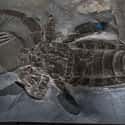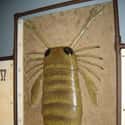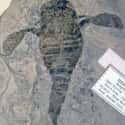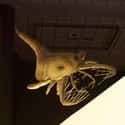-
(#1) Their Claws Could Be Over 19 Inches Long
The Jaekelopterus rhenaniae species of eurypterids, nicknamed "Jake," had a pincer claw measuring a half-meter. For those who don't follow the metric system, that is over one-and-a-half feet long! Paleontologist Markus Poschmann found the fossilized claw in a quarry in Germany, almost inadvertently while on a random hunt for other fossils in 2010.
Poschmann's crew was removing sediment from ancient slabs of siltstone at the bottom of a body of water, and Poschmann noticed "a dark patch of organic matter." This matter turned out to be an appendage used to gouge fish and snatch up other sea life. Some think such fish developed thicker exoskeletons as an evolutionary response to Jake's claws and hunting style.
-
(#2) They Adapted To Live On Land And In Water
Some eurypterids had the ability to breathe while in water and on land. One of the first animals to make the evolutionary leap from sea to shore, they periodically left the safety of their shells. Like other arthropods, these sea scorpions had exoskeletons that they could shed.
Since eurypterids' legs were designed for swimming, when they were on land, they likely had a difficult time moving around. The water might have restricted larger varieties because their legs could not support their body weight on land.
-
(#3) They Could Grow Larger Than An Adult Human
Eurypterids are thought to be the largest arthropods ever to have existed. The biggest may have exceeded eight feet in length, making them larger than the average height of an adult human. These creatures got around on eight primary legs with two paddle legs on their rear, which they used to swim in the muddy shallows during the Paleozoic Era.
These creatures were not only tall, but they likely had an impressive girth as well.
-
(#4) Some Of Them Ate Other Eurypterids
According to Dr. Simon Braddy from the University of Bristol, the eurypterids "would congregate en mass on the beaches... sometimes during this mass congregation, they would eat one another." Apparently, not even eurypterids were safe from other eurypterids.
The creatures shed their exoskeletons during these scorpion gatherings, leaving some vulnerable to their hungry kin. They clashed over resources or mates, and oftentimes the loser became lunch.
-
(#5) They Weren't Really Scorpions
While sea scorpions and present-day scorpions resemble one another and probably share a common ancestor, the truth is they aren't scorpions at all. Scorpions are most well-known for their stingers. As for sea scorpions, their claws are similar to modern-day scorpions, and they also have tails called telsons.
On the contrary, however, the sea scorpion's stingers did not produce venom.
-
(#6) They Lived In Prehistoric Craters
A large fossil bed containing the remains of over 100 eurypterids was discovered in a meteorite impact crater near Decorah, IA. Such craters were created about 460 million years ago when the planet was pelted with incoming meteorites.
As the millennia passed, these craters filled up with water and became seas that offered an ideal habitat for sea scorpions.
-
(#7) Sea Scorpions Lived All Over The World
Not only did these creatures live on land and sea, but they also existed all around the world. Some varieties lived in wetlands and their corresponding water sources. The giant Jaekelopterus rhenaniae is only known to have lived in Germany, but subspecies have turned up across the globe.
In 2015, researchers found a fossil bed in the Upper Iowa River with over 150 fossil fragments of different eurypterids. At the time these creatures were alive, Europe, North America, and portions of Asia were part of a supercontinent called Laurussia; eurypterids most likely inhabited this land mass's coastlines and shallow inland bodies of water.
Eurypterids' fossils have also turned up in Australia and Scotland, as well as in the United States, including New York, Washington, and Pennsylvania. A species of eurypterid called Eurypterus rempise is the state fossil of New York.
-

(#8) They Were Perhaps Fierce Predators
Given the creatures' size and claws that protruded in front of their mouths, experts once thought eurypterids were top predators. They had the advantage of being able to quickly swim through the water, as they relied on fish and other sea life for sustenance.
This hypothesis appears more likely to be applicable before eurypterids' prey began to adapt and develop better defense mechanisms. Other research suggests eurypterids were bottom feeders that preyed on soft-skinned animals along the sea bed. Despite their massive size, later generations of eurypterids lacked good eyesight, making it difficult to swiftly pick off other creatures.
-
(#9) Their Bodies Changed As They Grew
Eurypterids' hind limbs were paddle-shaped with locked joints that perhaps functioned like oars. These back legs were ideal for digging and swimming along the seafloor. Other limbs cropped out towards the front of the creature's body to support the animal's weight and help it grab prey. The rear limbs were shorter than those in front, suggesting they walked on six legs.
These specialized limbs supposedly became more refined with age. Younger sea scorpions had different back curvature than adults since their spines changed as they matured.
Yale professor James Lamsdell claims, "It looks like the juveniles would have behaved more like horseshoe crabs, [as they] sort of walked around on the seafloor, grubbing in the mud, just eating worms or whatever they could find."
-
(#10) No One Is Sure Why They Got So Big
There are competing theories as to why ancient sea scorpions grew to be so large. Some say it is because there was a lot more oxygen in the atmosphere during the Ordovician period when eurypterids lived, which may have allowed insects and arthropods to become gigantic compared to their surviving evolutionary descendants.
Another theory postulates eurypterids had to evolve so they could continue to hunt their prey. Since their food was also evolving, they needed to get bigger to deal with harder shells. The lower gravity caused by the displacement of mass in water may have also contributed to their gargantuan size.
-
(#11) Big Claws Couldn’t Make Up For Poor Vision
Yale professor of geology and geophysics Derek Briggs was part of a team that completed a paper entitled "What big eyes you have: the ecological role of giant pterygotid eurypterids." The study analyzed sea scorpions' vision and deduced the creatures perhaps couldn't see too well. Murky swamp water and the placement of the animals' eyes could have led to inferior eyesight.
They concluded the beasts were probably not dominant predators like scientists had previously thought since it's hard to hunt things without good vision. Briggs said:
Our analysis shows that they could not see as well as other eurypterids and may have lived in dark or cloudy water. If their claws could not penetrate the armor of contemporary fish, the shells of cephalopods, or possibly even the cuticle of other eurypterids, they may have preyed on soft-bodied, slower-moving prey.
-

(#12) They Are Now Extinct
Eurypterids lived for about 200 million years. However, like many other prehistoric creatures, they are now extinct. One possible reason for their extinction is their prey could have evolved to protect themselves with thicker skin and stronger jaws. Unable to compete in an ecosystem they once dominated, the beasts were potentially forced onto land where they had to adapt and consequently decreased in size over time.
Giant scorpions most likely ceased to exist during the Permian mass extinction, when close to 90% of life on Earth perished due to toxic rain caused by extreme volcanic activity. Fortunately, at no point in time did they coexist with human beings.
-
(#13) They Lived About 500 Million Years Ago
Sea scorpions are prehistoric ancestors of modern-day horseshoe crabs and spiders. They lived about 250-500 million years ago during the Silurian, Devonian and Permian eras. One set of fossils found in Germany by Markus Poschmann are also the largest-known eurypterids from the Ordovician period.
Scientists estimate this period began approximately 488 million years ago.
New Random Displays Display All By Ranking
About This Tool
The sea scorpion is a kind of ancient sea creature with a body length of 1 to 2 meters. It existed on the earth 500 million years ago and a giant among arthropods. Fossils of giant sea scorpions have been found in the United Kingdom and the United States, the largest and oldest sea scorpion fossil ever discovered was unearthed in Iowa.
The sea scorpions have sharp and slender arm-length claws that can grab the prey and push it into their mouths. This is obvious that the sea scorpion is a very aggressive animal. You could learn 13 facts about the sea scorpion with this random tool.
Our data comes from Ranker, If you want to participate in the ranking of items displayed on this page, please click here.




















